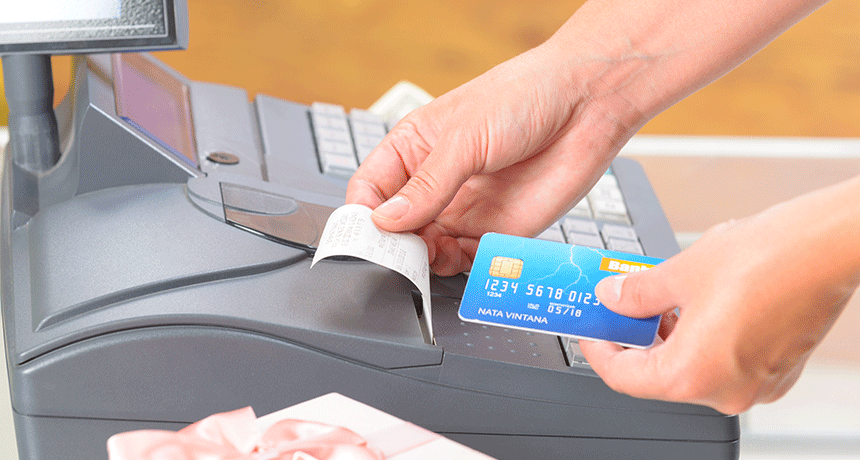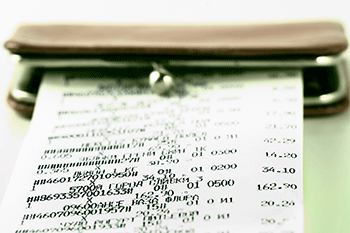Explainer: Store receipts and BPA
A hormone-mimicking chemical can be found in paper copies of cash-register sales

Most credit-card and store receipts use thermal paper to print out a record of purchases. That paper may contain BPA, a chemical that can inappropriately fool the body into thinking it’s a hormone.
humonia/iStockphoto
By Janet Raloff
If you ever go shopping with scientists who study toxic chemicals, pay attention to what they do with a receipt. Some of them will stick that slip of paper into a zip-it-closed plastic baggie, not their pockets and wallets. Others will ask for a digital receipt. Why? It’s because there’s probably a chemical coating on that paper that contains bisphenol A, or BPA.
BPA is used for a host of different purposes. It is broadly used as a chemical building block of polycarbonate (Pah-lee-KAR-bo-nayt) plastics and of epoxy resins. Polycarbonates are hard, clear plastics that have an almost glasslike finish. They have been used to make water bottles, baby bottles, kitchen appliance bowls and more. The resins show up in a host of materials, including paints, adhesives and protective coatings — including clear coatings on the inside of food cans and on the outside of children’s teeth. BPA also ends up on some kinds of paper.
John C. Warner is a chemist. While working at Polaroid Corporation in the 1990s, he learned about the chemistry behind the papers now used for most receipts. These are known as thermal papers. To make some of them, manufacturers would coat a powdery layer of BPA onto one side of a piece of paper together with an invisible ink, Warner learned. “Later, when you applied pressure or heat, they would merge together and you’d get color.”
Warner thought little about such papers other than their design was clever. Until, that is, BPA exploded into the news in the early 2000s. At that point, he says, he began to have some doubts.
Research had begun showing that BPA could mimic the action of estrogen. That’s the primary female sex hormone in mammals and many other classes of animals. In the womb, studies found, BPA could disrupt the normal development of a rodent’s reproductive organs. And some animal studies found that BPA might even raise the risk of cancer.
This is a worry because BPA doesn’t stay locked inside the products that contain it. Studies showed that BPA can leach out of polycarbonate plastic. It also leaches out of can linings and into canned goods. It even had been found in the saliva of children whose teeth had been treated with a BPA-based resin (in hopes of limiting cavities).

By the early 2000s, Warner was teaching green chemistry at the University of Massachusetts in Boston and Lowell. “I’d send my students out to local stores to get their cash register receipts.” Back in the lab, they’d dissolve the paper. Then they’d run it through a mass spectrometer. This instrument could analyze the chemical composition of materials. A simple glance at its output would show whether there was a telltale spike signaling BPA.
And his students indeed found it, Warner says. Not in every receipt. But in plenty. Receipt papers that used BPA looked no different than ones that didn’t.
Paper can be a major source of BPA
Until at least 2009, neither the public nor the general science community had been aware of receipt papers as a potentially important source of exposure to BPA.
In many cases, Warner found, the amounts of it in paper were not trivial.
“When people talk about polycarbonate bottles, they talk about nanogram quantities of BPA [leaching out],” Warner observed back around 2009. A nanogram is a billionth of a gram. “The average cash register receipt that’s out there and uses the BPA technology will have 60 to 100 milligrams of free BPA,” he reported several years back. That’s a million times more than what ends up in a bottle. (By free, he explained, it’s not bound into a polymer, like the BPA in a bottle. The individual molecules are loose and ready for uptake.)
As such, he argued, when it comes to BPA, for most people “the biggest exposures, in my opinion, will be these cash register receipts.”
Once on the fingers, BPA can be transferred to foods. A number of hormones — including estrogen — can be delivered through the skin by controlled-release patches. So, some scientists began to worry about whether BPA, too, might enter the skin.
In 2011, toxicologists showed it did. Two teams published data showing BPA could pass into the body through skin. Three years later, a team of university and government scientists showed that handling receipt paper could bring BPA into the body.
Paper companies started getting concerned. Before long, some began substituting other BPA relatives in their thermal-paper “inks.” Follow-up research would show, however, that some of these chemicals were as hormone-like as BPA was, at least in animal studies.
Several public-interest groups have been petitioning for companies to label any receipt papers that contain BPA (or one of its chemical cousins). That way, pregnant women would know to wash their hands after picking up a BPA-laced receipt. They would also know to keep it out of the hands of babies that might put fingers that handled such receipts into their mouths.







